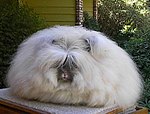Portal:Lagomorpha
(Redirected from Portal:Rabbits and hares)
The Lagomorpha portalThe lagomorphs (/ˈlæɡəmɔːrf/) are the members of the taxonomic order Lagomorpha, of which there are two living families: the Leporidae (rabbits and hares) and the Ochotonidae (pikas). There are 110 recent species of lagomorph of which 109 are extant, including 10 genera of rabbits (42 species), 1 genus of hare (33 species) and 1 genus of pika (34 species). The name of the order is derived from the Ancient Greek lagos (λαγώς, "hare") + morphē (μορφή, "form"). (Full article...) Selected article
The black-tailed jackrabbit (Lepus californicus), also known as the American desert hare, is a common hare of the western United States and Mexico, where it is found at elevations from sea level to up to 10,000 feet (3,000 m). Reaching a length of about 2 feet (61 cm) and a weight from 3 to 6 pounds (1.4 to 2.7 kg), the black-tailed jackrabbit is the third largest North American hare, after the antelope jackrabbit and the white-tailed jackrabbit. Like other jackrabbits, the blacktail has distinctive long ears and the long, powerful rear legs characteristic of hares. Young are born fully furred with eyes open; they are well camouflaged and are mobile within minutes of birth. (Full article...)
Selected breed
The Angora rabbit (Turkish: Ankara tavşanı) is a variety of domestic rabbit bred for its long, soft wool. The Angora is one of the oldest types of domestic rabbit, originating in Ankara, Turkey, along with the Angora cat and Angora goat. The rabbits were popular pets with French royalty in the mid 18th century, and spread to other parts of Europe by the end of the century. They first appeared in the United States in the early 20th century. They are bred largely for their long Angora wool, which may be removed by shearing, combing, or plucking. There are many individual breeds of Angora rabbits, four of which are ARBA-recognized.
Selected quote
SubcategoriesRelated portalsSelected image Reversible figure optical illusion — is it a duck or a rabbit? ...or a duck? ...or a rabbit? The rabbit–duck illusion is an ambiguous image first published in the German humor magazine Fliegende Blätter in 1892. It can either be interpreted as the head of a duck (facing left) or a rabbit (facing right). Joseph Jastrow (1863–1944), an American psychologist, noted for inventions in experimental psychology, design of experiments, and psycho-physics, popularized this image and was once considered its creator. The German Fraktur text reads Welche Thiere gleichen einander am meisten? ("Which two animals look most alike?")—Kaninchen und Ente. ("Rabbit and duck.")
Selected video
Did you know"Rabbit" in…Get involvedFor editor resources and to collaborate with other editors on improving Wikipedia's Lagomorpha-related articles, see WikiProject Mammals. Things you can do
TopicsAssociated WikimediaThe following Wikimedia Foundation sister projects provide more on this subject:
|














